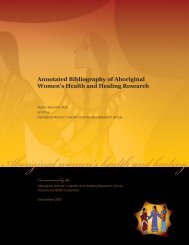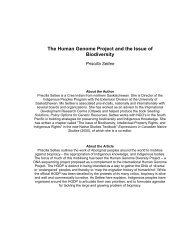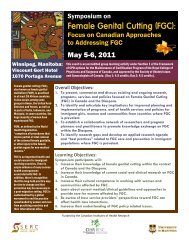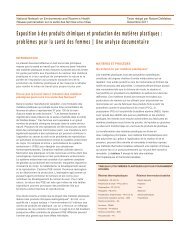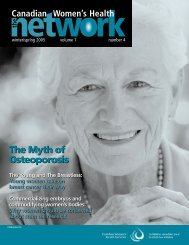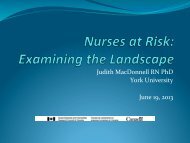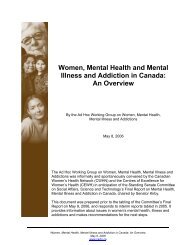here. - Canadian Women's Health Network
here. - Canadian Women's Health Network
here. - Canadian Women's Health Network
- No tags were found...
Create successful ePaper yourself
Turn your PDF publications into a flip-book with our unique Google optimized e-Paper software.
EXECUTIVE SUMMARYTHE LINK between poverty and poor health is well established and makes commonsense. T<strong>here</strong> are many ways in which poverty can lead to ill health, including lack ofaccess to affordable housing, transportation, food and non-insured health benefits,such as medications.Poverty also discriminates in more subtle ways. For example, women and their childrenwho are poor are more likely to be socially isolated, which also contributes to ill health.We do not yet completely understand all of the ways in which low income and incomeinequality in our society lead to poor health. But we do not need to completelyunderstand these mechanisms in order to act now to improve health.The link between income and health has a special importance for women. In Manitoba (asin the rest of Canada), poverty discriminates, striking women substantially more frequentlyand more severely than men. This study looks at that disparity and how income inequalityaffects the health not only of women living in poverty but of everyone in our society.Women, Income and<strong>Health</strong> in Manitoba5Income and InequalityPoverty is a serious issue in Manitoba.This province has the country’s thirdhighest rate of poverty (18.5%) among<strong>Canadian</strong> provinces, compared to 16.2%for all of Canada. For women, the pictureworsens: 19.9% of Manitoba women aged18 and over were poor in 1999. 1 This alsohas an impact on the lives of children andManitoba also has the second highest childpoverty rate in Canada, 23.7%. 2The disparity between women and men isremarkable. In 1999, t<strong>here</strong> were 29,000 morepoor women in Manitoba than poor men –a difference of 54%. 3Marriage does not protect women frompoverty. In 1996, one in ten married coupleswere poor. And married women’s earningsare vital to their families’ well-being; withoutthem, that proportion would have risen toone in four. 4Minimum wage earners, even thoseworking full-time, live in poverty. A singlemother with one child working full-timeand earning minimum wage in Manitobalives 43.4% below the poverty line. If she ismarried with two children, even when bothspouses work full-time at minimum wage,their family will live 25% below thepoverty line.Some groups of women are especiallyvulnerable to poverty:■■■More than half (51.3%) of seniorwomen who live alone are poor. 5This has remained virtuallyunchanged in the last thirty years.Women with disabilities also face ahigher risk of poverty. In 1997, 27%of women with disabilities, aged 16 to64, lived in poverty. Almost two-thirdsof those lived more than 25% belowthe Low Income Cut Off. 6Aboriginal women are more likely tolive in poverty than non-Aboriginalwomen or Aboriginal men. In 1995,42.7% of Aboriginal women(excluding those who lived onReserves and those living in theTerritories) lived in poverty, comparedto 35.1% of Aboriginal men, 20.3%of non-Aboriginal women and 16.4%of non-Aboriginal men. 71Statistics Canada, Income in Canada, Table 8.52Social Planning Council of Winnipeg, Promises Not Kept:2001 Report on Child Poverty in Manitoba3Statistics Canada, op. cit, Table 8.54National Council of Welfare, Poverty Profile 1996, p 875Statistics Canada, op. cit., Table 56Federal, Provincial and Territorial Ministers Responsible forSocial Services, In Unison 2000: Persons with Disabilities inCanada, page 797Statistics Canada, Women in Canada 2000, page 268




